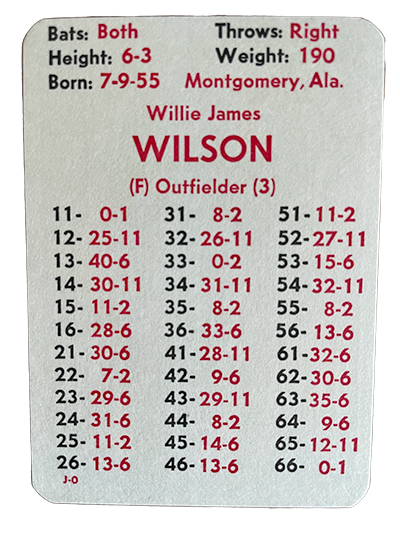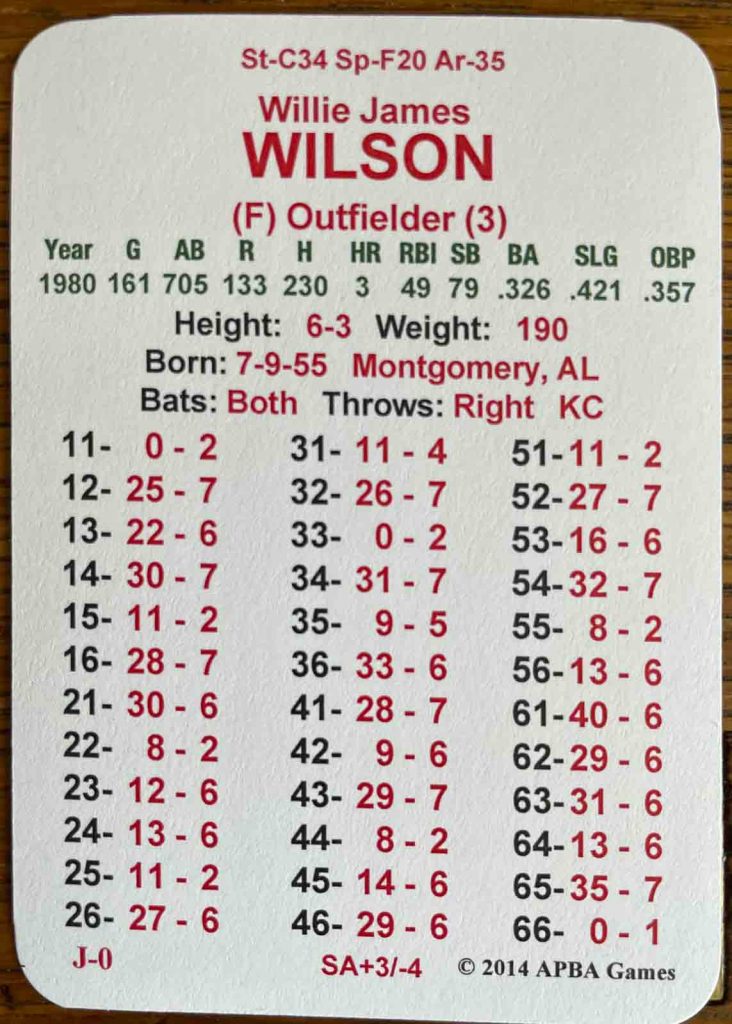Rich Zawadzki helped me out with Monster Monday this week with two cards… of the same player from the same season. Right here, we’re looking at the original 1980 Willie Wilson of the Kansas City Royals.

1980 Willie Wilson
.326 batting average
79 steals
Led AL with:
- 705 at-bats
- 230 hits
- 133 runs
- 15 triples
Obviously not your typical slugging monster card, Wilson contributed with his legs. Willie stole 79 bases and was only caught ten times. He also had a great year with the bat. With a league-leading 230 hits, he batted .326.
Overall, he led the AL in at-bats (705), runs (133), hits (230) and triples (15). Interestingly, he did NOT lead in steals. That honor went to Rickey Henderson who had 100 thefts.
Still, his effort was good enough place Wilson fourth in the AL MVP voting.
Rich pointed out that Wilson’s 705 at-bats was a MLB record which stood until Jimmy Rollins broke it in 2007. Wilson still remains second all time.
| Split | G | PA | AB | R | H | 2B | 3B | HR | RBI | SB | CS | BB | SO | BA | OBP | SLG |
|---|---|---|---|---|---|---|---|---|---|---|---|---|---|---|---|---|
| 1980 Totals | 161 | 745 | 705 | 133 | 230 | 28 | 15 | 3 | 49 | 79 | 10 | 28 | 81 | .326 | .357 | .421 |
Wonderful Willie
There’s a lot to like with Wilson’s 1980 card but be forewarned, you won’t hit many homeruns with it. Willie hit three in a very full season so he only has two second column 1s behind three 0s. That said, you may hit a lot of triples. Wilson has nine 2s in the second column to replicate his league leading total of 15.
And the 11s! So many 11s on Wilson’s 1980 card! All told, he has three elevens in the first column and nine more in the second column.
Even with all of the elevens on his card, Wilson earned a 22-7 due to his .326 batting average. That gives him a 35-8 and a 64-9.
Not surprisingly, Wilson’s card doesn’t have any 24s. He has a 41-28 due to only four GIDP in 1980. He does have a 53-15 thanks to six hit by pitches that season.
Wilson is fast, of course, and is rated an OF-3.
Finally, Wilson only has one 14s but also only has three 13s. I looked at his stats and was surprised he struck out 81 times (yes, that was a high amount for a season at one time). But considering that Wilson’s 745 plate appearances, it shouldn’t be too surprising that the 13 count is low.
2014 reprint
I mentioned a second 1980 Wilson APBA card that Pastor Rich had sent. It’s the reprint that was published in 2014.
Here is the card.
A few of the key differences:
- One extra 11 at 31
- a 22-8 instead of a 22-7
- a 13-22 instead of a 53-15
- only one 1 (and a 4) in the second column. On the plus side, no 11s in the second column
And of course, this was after APBA permanently moved the 12 to 23. Honestly, I miss the migrating 12 but putting it on a number that usually hosts the same number (such as this case with the 65) is not ideal.
While the extra 11 is nice in Wilson’s reprint, the original 1980 seems to be much more productive in my opinion.
Thanks to Pastor Rich!





The original is better, as you noted. It would probably have a batting average .015 higher.
Can’t honestly say whether one is better than the other – I’ll trust the math Gents. But, there is something interesting about 2nd Column SBs – a pleasant reward, different than an extra-base hit. I play Automatic SBs, with the “8 & 9 Catcher” Mod, for innings 1-6. When the game gets into “crunch-time”, I implement MG stealing. Suffice to say, Wilson’s 1980 is a treat either way, either print.